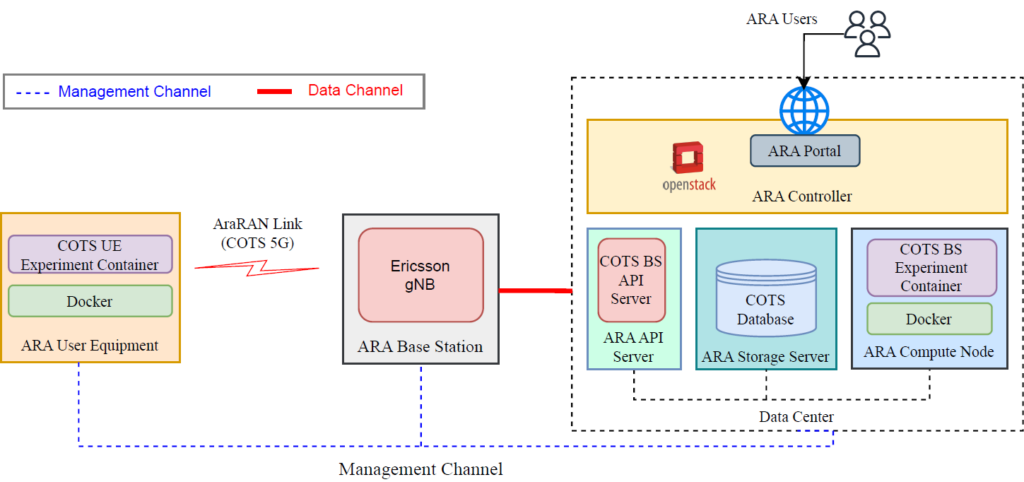Besides its fully-programmable SDR infrastructure and the TVWS massive MIMO infrastructure, ARA employs commercial-off-the-shelf (COTS) 5G massive MIMO systems at the mid-band and mmWave band, providing the robustness and performance needed for data-intensive applications such as agriculture automation and XR-based rural education. In collaboration with Ericsson, ARA provides rich configuration and measurement APIs to enable real-world measurement studies of mid-band and mmWave band massive MIMO behavior that would be infeasible otherwise.
The following figures demonstrate the field deployment of Ericsson AIR 6419 and AIR 5322 mid-band and mmWave band massive MIMO systems in ARA.

Key Features of ARA COTS 5G Infrastructure
- COTS 5G SA Massive MIMO with 3-D Beamforming and NR-DC: ARA deploys four Ericsson base station sites in agriculture farms and rural communities. Each base station site is equipped with the following state of the art COTS 5G radios:
- Ericsson AIR 6419 operating in the n77 5G band (3.45 – 3.55 GHz) with 192 antennas, supporting up to 16 layers of MU-MIMO;
- Ericsson AIR 5322 operating in the n261 frequency band (27.5 – 27.9 GHz) with 256 antennas, supporting up to 8 layers of MU-MIMO.
- COTS 5G User Equipment (UE): 20+ field deployed UE stations using the Quectel RG530 module with 4 Transmit and Receive (TRX) antennas for the mid-band n77 and 4 TRX antennas for the mmWave.
- Performance & Programmability: The mid-band and mmWave band radios operate in the 5G Stand-Alone (SA) mode and support New Radio Dual Connectivity (NR-DC) with the mmWave carrier anchored at mid-band carrier, providing an aggregate communication capacity up to 3+ Gbps per sector and enabling advanced wireless applications such as agriculture automation. Through first-of-its-kind configuration and measurement APIs, the ARA COTS 5G infrastructure enables users to collect extensive real-world measurement data about 5G massive MIMO systems at scale, thus enabling integrative wireless studies and application pilots.
Enabled Experiments
The ARA COTS 5G infrastructure is readily accessible remotely via the ARA Portal. Users can reserve the “COST UE Experiment Container” and ”COTS BS Experiment Container” as shown in the figure below to access the ARA COTS 5G experiment capability.

The unique COTS 5G experiments are enabled by the configuration and measurement APIs ARA provides for its COTS 5G UEs and BSes:
- COST UE API is currently available, and it provides 5G channel information (e.g., RSRP, SINR, and RSRQ) for the mid-band and mmWave serving cell.
- COST BS API is being developed and expected to be made available later in 2024:
- Frequency, Numerology, TDD UL DL Pattern, etc
- Basic Physical Signals, Channels configurations
- Rach Preamble Format/Preamble Target Power, SSB Duration/Offset/Periodicity/power boosting
- The number of symbols configured for PDCCH
- Maximum Tx Power, etc.
- Transmission Mode (TM)
- TM7/8/9 Enabling in PCell/SCell
- Configure TM switches between TM3 and TM7/8r, etc.
- Reference Signal (RS)
- Channel State Information Reference Signal (CSI-RS): 8/16/32-Port and associated Codebook configurations
- Demodulation Reference Signal (DMRS): SINR threshold for DMRS based downlink MU-MIMO user selection, Maximum number of layers, TM8-based MU-MIMO
- Sounding Reference Signal (SRS): Periodic/Aperiodic mapping in time-frequency resource, 5/10/20/40/80 slots Periodicity
- Phase Tracking Reference Signal (PTRS): PTRS Enabling for High-Band
- Tracking Reference Signal(TRS): power boosting, etc.
- Beamforming Types
- Code-based/Reciprocity-based beamforming, etc.
- KPIs on gNB:
- CSI (CQI, RI, PMI) KPIs: Distribution of UE-reported CQI values related to different ranks; Distribution of PMIs reported by UE for different RIs codebook, etc.
- SU-MIMO/MU-MIMO KPIs: Average number of PDSCH layers; Average Active SRS Users; Average Codebook MIMO PDSCH Resource Block Symbol Utilization; Distribution of aggregated number of resource block symbols used for PDSCH by different number of users/co-scheduled layers as a result of SU-MIMO or MU-MIMO, etc.